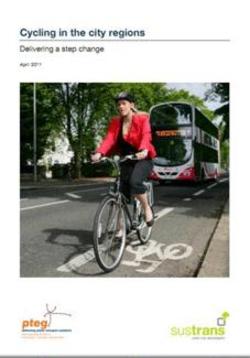
Organisation: Sustrans and Passenger Transport Executive Group
Date uploaded: 19th May 2011
Date published/launched: April 2011
This report by Sustrans for the Passenger Transport Executive Group explores the potential impact of a step change in the delivery of interventions to support and promote cycling in the English city regions outside of London.

The review of the existing evidence base suggests that:
• There is significant potential for a step change in levels of cycling in the city regions, particularly given that close to 50% of all journeys in the city regions are relatively local in nature.
• Increasing cycling can produce substantial economic benefits mainly by increasing physical activity through reduced congestion, lower carbon emissions, increasing physical activity and by improving access to employment, local facilities and public transport.
• Investment in cycling is highly cost-effective, delivering benefits at least three times higher than the costs.
Information gathered about existing PTE cycling initiatives shows that:
• Coordinated programmes of measures to increase cycling and change travel behaviour, targeted at key destinations, have achieved some increases in cycling in the city regions.
• However, investment levels and the overall priority given to increasing cycling levels have been relatively modest, in particular when set against recent national demonstration programmes.
• Existing best practice highlights the value of having a coherent strategy and shared objectives for increasing cycling in order to target resources where there is the greatest potential for change.
Modelling of area-wide and targeted interventions to increase cycling suggests that:
• A step change in the scale of sustainable travel programmes which include cycling as part of a wider package of behaviour change measures could more than double levels of cycling and deliver a beneficial impact on overall travel patterns within the PTE areas.
• Interventions aimed at increasing cycling for specific types of journey, such as access to public transport interchanges, schools and workplaces, can deliver a significant mode shift away from car use.
• Although measures to improve access by cycle to public transport could substantially reduce pressure on station parking and local road networks, there is as yet very limited evidence on the scope for improved station access on overall demand levels overall.
For more information contact:
Wendy Johnson
